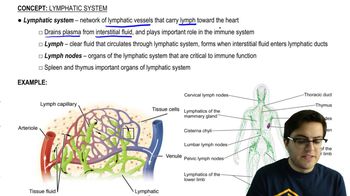Here are the essential concepts you must grasp in order to answer the question correctly.
Respiratory Systems
Respiratory systems are biological structures that facilitate the exchange of gases, primarily oxygen and carbon dioxide, between an organism and its environment. Different organisms have evolved various respiratory systems suited to their habitats, such as lungs in vertebrates, gills in fish, and tracheae in insects. Understanding these systems is crucial for analyzing how organisms adapt to their environments and meet their metabolic needs.
Recommended video:
Blood Supply and Gas Exchange
In many respiratory systems, a close association with a blood supply is essential for efficient gas exchange. Blood vessels transport oxygen from the respiratory surface to tissues and carry carbon dioxide back for exhalation. However, some organisms, like insects, utilize a tracheal system that delivers oxygen directly to cells without the need for a circulatory system, highlighting the diversity of respiratory adaptations.
Recommended video:
Gas Exchange and Breathing
Tracheal System in Insects
The tracheal system is a network of tubes that transport air directly to the tissues of insects, allowing for efficient gas exchange without relying on a blood supply. This system consists of spiracles that open to the outside and lead to a series of branching tubes called tracheae. The direct delivery of oxygen to cells enables insects to thrive in various environments, but it also means their respiratory system is less dependent on blood circulation compared to vertebrates and other organisms.
Recommended video:
 Verified step by step guidance
Verified step by step guidance


